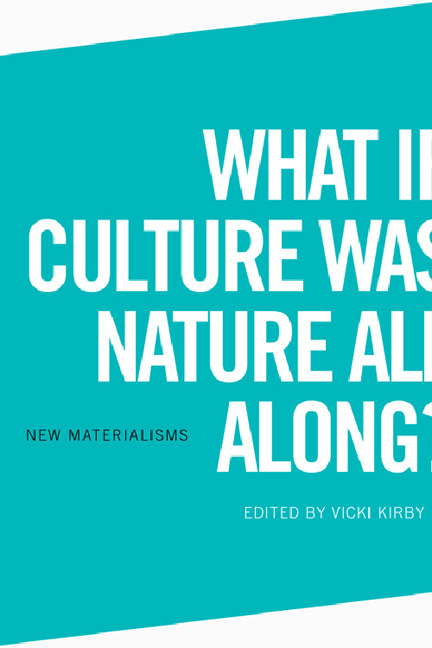Book contents
- Frontmatter
- Contents
- Acknowledgements
- Foreword
- 1 Matter out of Place: ‘New Materialism’ in Review
- 2 Method Matters: The Ethics of Exclusion
- 3 Sensory Substitution: The Plasticity of the Eye/I
- 4 Allergy as the Puzzle of Causality
- 5 Pregnant Men: Paternal Postnatal Depression and a Culture of Hormones
- 6 Material Culture: Epigenetics and the Molecularisation of the Social
- 7 Racialised Visual Encounters
- 8 Microbiology as Sociology: The Strange Sociality of Slime
- 9 Nature Represents Itself: Bibliophilia in a Changing Climate
- 10 Climate Change, Socially Synchronised: Are We Really Running out of Time?
- 11 A Sociality of Death: Towards a New Materialist Politics and Ethics of Life Itself
- Notes on Contributors
- Index
1 - Matter out of Place: ‘New Materialism’ in Review
Published online by Cambridge University Press: 22 December 2017
- Frontmatter
- Contents
- Acknowledgements
- Foreword
- 1 Matter out of Place: ‘New Materialism’ in Review
- 2 Method Matters: The Ethics of Exclusion
- 3 Sensory Substitution: The Plasticity of the Eye/I
- 4 Allergy as the Puzzle of Causality
- 5 Pregnant Men: Paternal Postnatal Depression and a Culture of Hormones
- 6 Material Culture: Epigenetics and the Molecularisation of the Social
- 7 Racialised Visual Encounters
- 8 Microbiology as Sociology: The Strange Sociality of Slime
- 9 Nature Represents Itself: Bibliophilia in a Changing Climate
- 10 Climate Change, Socially Synchronised: Are We Really Running out of Time?
- 11 A Sociality of Death: Towards a New Materialist Politics and Ethics of Life Itself
- Notes on Contributors
- Index
Summary
Background to a Problem
There once was a time, a time that includes the present, when scientific observation was equated with objectivity, when perception was thought to be a transparent and neutral act, and when the identification of mind and reason as incorporeal and transcendent over nature was pre-requisite to the determination of truth. Although a plethora of research in the sciences actually contests such ill-informed assertions, this cartoon representation of science fundamentals is widely held. Many science practitioners continue to explain their goals and achievements in such terms, and perhaps ironically, even cultural and social analysts who reject them may require this caricature as their interventionary departure point. But whether we hail from the humanities, the social sciences or the sciences, and however we image or represent our opinions and observations, we are all caught in the business of knowledge notation. This is a shared human practice regardless of disciplinary commitments. Consequently, a major concern in cultural and social analysis is to understand how symbolic systems actually connect to, or reflect, what they purportedly re-present. And yet the question is not unknown in the sciences.
Theoretical physicist and mathematician, Eugene Wigner, acknowledges the conundrum of representation in ‘The Unreasonable Effectiveness of Mathematics in the Natural Sciences’ (1960). Aiming to capture a riddle whose mysteries are almost invisible because commonplace, he contrives a scene where two old school chums are catching up and chatting about their respective occupations. One of them, a statistician working on population trends, illustrates what his work involves by showing his friend the Gaussian distribution tables that symbolise specific aspects of a particular demographic. However, as the statistician dilates on the implications of the diagrams his friend becomes ‘incredulous’.
‘How can you know that?’ was his query. ‘And what is this symbol here?’ ‘Oh’, said the statistician, ‘this is π’. ‘What is that?’ ‘The ratio of the circumference of the circle to its diameter’. ‘Well, now you are pushing your joke too far’, said the classmate, ‘surely the population has nothing to do with the circumference of the circle’. (Wigner 1960: 1)
- Type
- Chapter
- Information
- What if Culture was Nature all Along? , pp. 1 - 25Publisher: Edinburgh University PressPrint publication year: 2017



